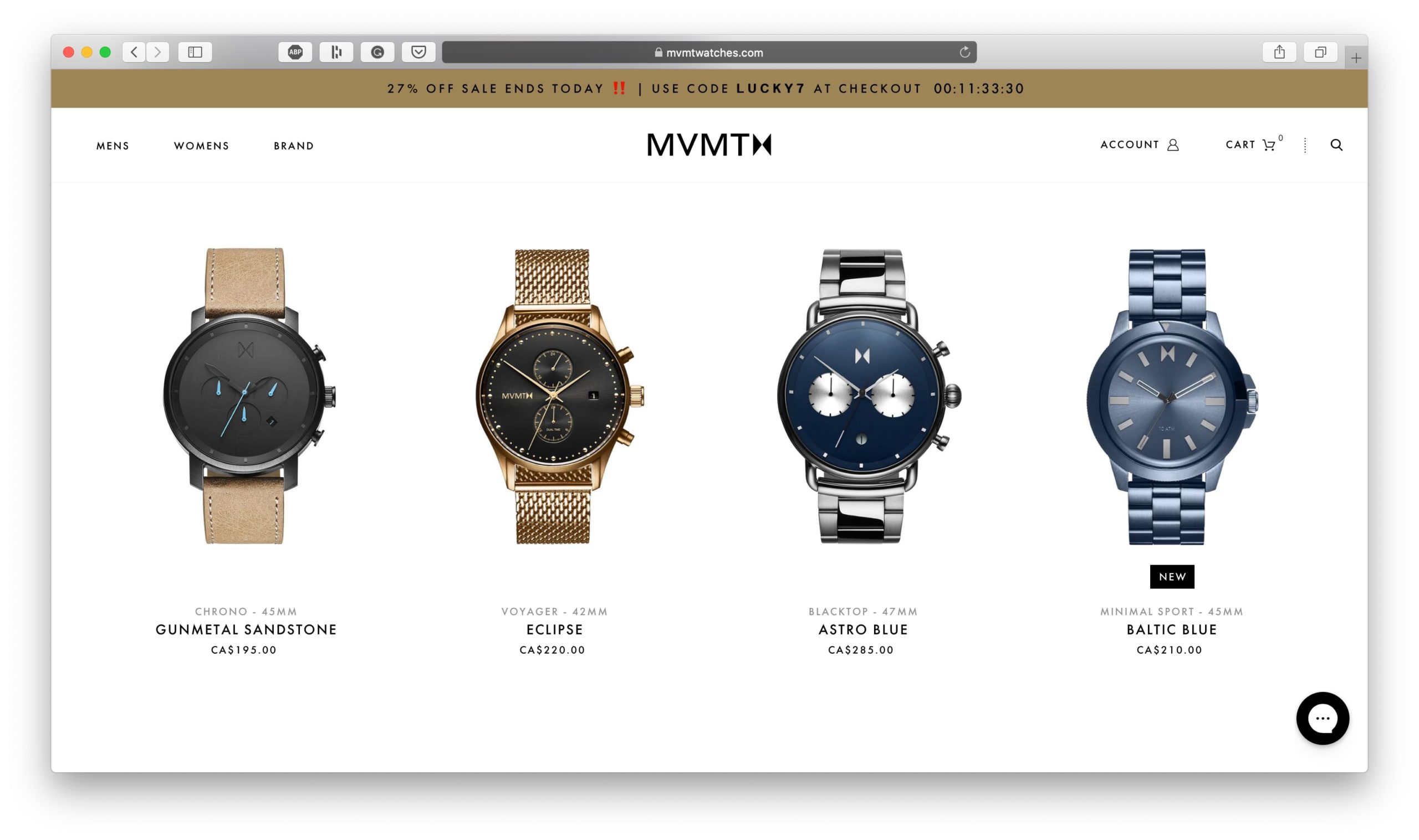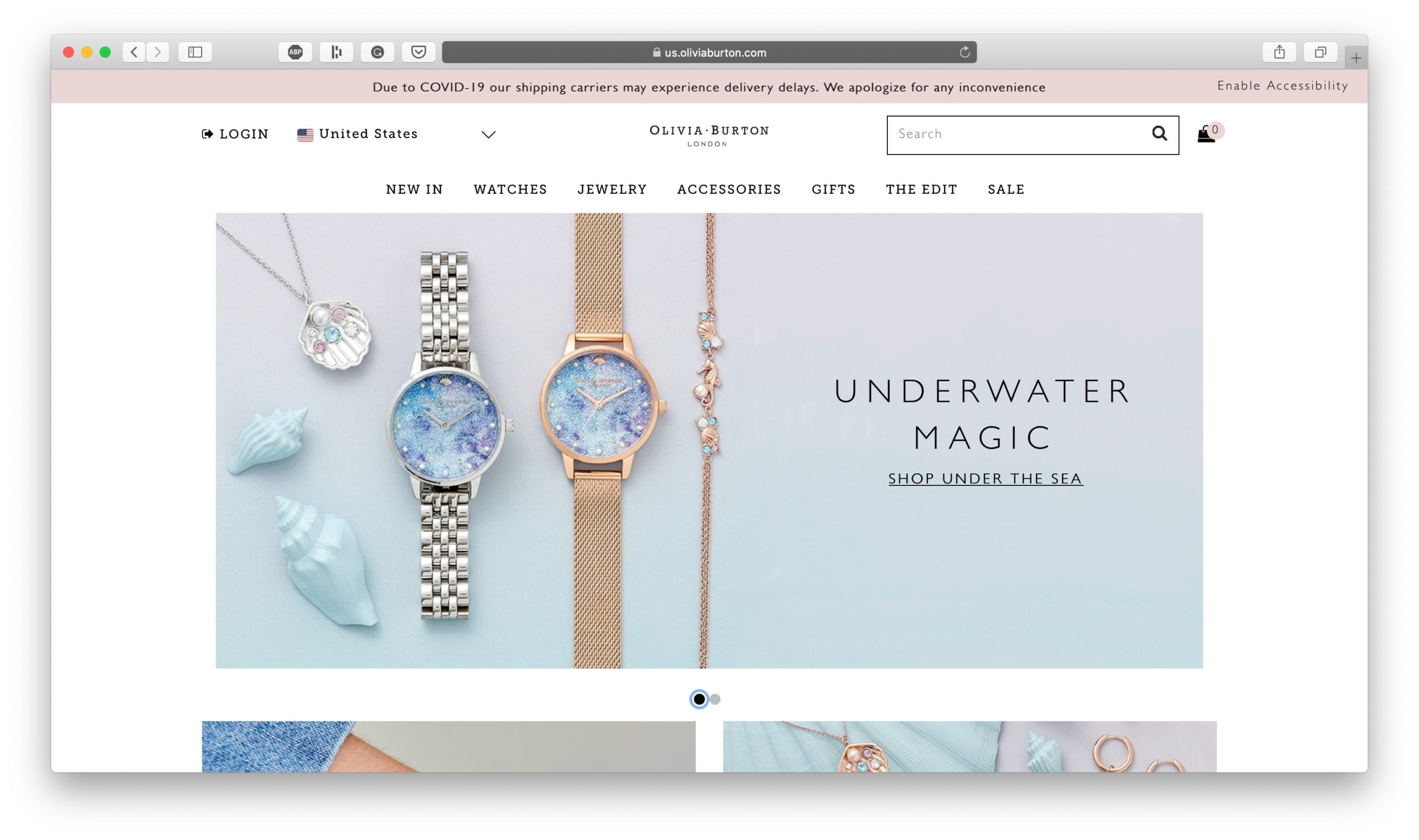
How to Start a Watch Brand
For most of us, we don’t need a timepiece on our wrist to tell the time anymore—cell phones have fulfilled that role for us—so why do people still wear watches and why do watch brands still exist?
Well, nowadays, wearing a watch is more about fashion, style, and social signaling. So if you’re looking for a business to start where you can really focus on creating a memorable brand that your audience can connect with, consider starting a watch brand.
If you don’t know much about watches other than that they tell the time, then you’re going to need to do some deeper digging before you start your brand.
In this post, we’ll walk you through the steps of starting a watch brand even if you don’t really know that much about watches. Plus, we’ll highlight some of the top direct-to-consumer watch brands on the market right now and analyze their branding strategy to see how they made themselves stand out in such a saturated market.
Got some time? Keep on reading.
Why Start a Watch Brand

People don’t buy a watch because they need a watch.
And that’s a good thing.
People buy watches because they want something to wear that signals to others that they’re sophisticated, classy, fashionable, sporty, and/or that they’re knowledgeable and appreciative of high-quality goods.
This means that you’re selling a product to consumers who have a disposable income to spend, and they value high-quality goods, which is a lucrative market to sell to.
Now, this doesn’t mean that your watches have to be super high-priced like Rolexes, or that you only have to cater to a luxury market of consumers, it just means that your products have to appeal to people who want to be that kind of person.
This gives you a lot of freedom to build a dynamic brand, so if that’s something that appeals to you, it’s a good reason to start a watch brand.
Alternatively, if you have an interest in watches and a passion for their craftsmanship, that’s also another good reason to start a watch brand. Many watch brands were founded by people who had a personal interest in watches before they started their own brand, so it’s possible to lead this kind of a business fueled by your passion.
And finally, the watch industry is a lucrative one. Revenue in the luxury watches industry amounts to over $23 million dollars in 2020 and the market is expected to grow annually by 6.2%, according to Statista. So if the flexibility to create a premium brand or a passion for watches wasn’t enough, then knowing that it’s a stable and growing market should be.
How to Start a Watch Brand When You Don’t Know Anything About Watches
But how do you actually start a watch brand if you don’t know anything about watches?
Sure, you might know what kind of watch styles you like or don’t like, you might know some of the basic terminologies, you might even have a little more advanced knowledge than the average person… But that doesn’t mean you actually know how to make or manufacture watches, so where do you start?
Firstly, watches are made up of a lot of different pieces so it helps to know the basics before you go any further.
- Bezel: The outer edge of the watch around the watch’s face.
- Case: This goes inside the bezel and holds together the face of the watch, the dial, and all the other inner-workings.
- Case Back: The backside of the watch which can be removed to access the inner workings of the watch. Case backs can sometimes be engraved or stamped.
- Crown: This usually sits on the outside of the watch and is used to wind the watch.
- Crystal: This is a transparent cover that lays on top of the watch face, protecting it.
- Face/Dial: This is the part of the watch that marks the time. It can also be decorative too, made with different colors, patterns, or materials.
- Hands: The hands of the watch point to the time. There are usually two—one to show the hour and one to show the minutes—but sometimes there can also be a third (to show the seconds).
- Lugs: These are the outer parts of the watch used to attach the whole watch case to the watch straps.
- Movement: The interior of a watch is called the movement. This is what makes a watch work, and some movements are tricky to make (like mechanical movements) so people who are passionate about watches pay attention to the movement’s craftsmanship. Other movements, like battery-powered Quartz movements, are easier to make and are more accurate.
- Signature: This is the brand’s logo or branding which is usually marked on the watch face to show which brand made the watch.
- Strap: These are the bands that clasp around the wrist to fasten the watch case to the wrist. These can be made of a variety of materials like metal, precious metals, ceramic, leather, canvas, or even wood. There are usually two separate straps that fasten to each lug, however, there can also be one continuous strap that loops through both lugs, lying alongside the case back of the watch.
- Subdial: Some watches will have smaller dials on the watch face which are used for additional purposes. Some can tell the time in other time zones, others might display the seconds, or they could even be a stopwatch.
Those are just a few of the basics to get started.
It’s also important to know the different types of watches that exist, so when you’re creating your watch brand you’ll have an idea of what kind of watches you want to make and sell.
Each watch type has a different function which usually impacts the features they have, how they look, how they’re made, and who uses them.
Some examples of different watches include:
- Mechanical Watches: These watches use clockwork mechanisms to track time, as opposed to a battery.
- Quartz Watches: These types of watches use batteries.
- Digital Watches: These watches display the time as numerical digits rather than as an analog clock face.
- Solar Watches: These watches are solar-powered.
- Dive Watches: These types of watches are waterproof.
- Luxury Watches: These types of watches are made with style, longevity, and brand heritage in mind while often being made of precious metals and/or jewels. They are also often mechanical watches meaning that the movement is not battery powered like a Quartz watch movement.
- Smart Watches: These watches usually have a touchscreen as the watch face and they perform similar functions as smartphones.
If you’re serious about starting a watch brand, you should learn as much as possible about watches—especially the types of watches you plan to sell—so you can find the right supplier to work with and ask them the right questions.
Check out online courses like these ones to further your watch knowledge:
How to Make Watches or Source Watches

To start a watch brand, you need products to sell! This means that you need to find watch suppliers or learn to make watches yourself.
We’ll walk through all of your options, so you can decide which one is the best fit for you.
Making Your Own Watches
Making your own watches is definitely possible, however, it can be quite technical depending on the type of watch you’re making.
Watches are small and their individual pieces are finicky, so putting one together takes some practice and finesse. For this reason, it’s in your best interest to learn from a pro and take your time learning the art of watchmaking before you actually sell any of your creations to customers.
The Learn Watchmaking course we mentioned above focuses specifically on making watches yourself, so if you want to make your own watch products, that’s a good place to start.
The main advantage of making your own watches is that they’ll be unique to your brand which matters to watch wearers and collectors who value craftsmanship but the main drawback is that learning how to make watches comes with a big learning curve.
Dropshipping Watches
If you don’t want to make your own watches by hand but you also aren’t quite ready to manufacture watches, another option is to dropship watch products.
Dropshipping watches enables you to not have to purchase inventory upfront, so it’s a more accessible way to start a watch brand on a budget.
You can find a supplier of watch products (like the watch suppliers listed on Spocket—check out our Spocket Review here) and list their products on your site. Once a customer places an order from your shop you can forward that order to the supplier and they’ll ship the order out to your customer. It takes a lot of the pressure off you to run and manage the technical parts of your business, plus you don’t have to put the money upfront to make your products or purchase any inventory.
The main advantage of sourcing watch products from dropshipping suppliers is that you can get your business set up quickly on a small budget but the main drawback is that you have little control over how the watches look, you won’t be able to add your own branding to the watch, and the profit margins will be slim.
Wholesaling Watches
If you want to sell watches but don’t necessarily want to sell your own brand of watches, you can start a boutique that carries several different types of watch brands. Many watch brands have wholesale programs and if you meet their criteria, you can purchase stock from them and sell their watches through your own site.
Starting a watch boutique can also be a great way to transition into selling your own brand of watches. Selling popular watch brands that consumers already know and love can bring traffic to your site, and once you have steady traffic and the funds to manufacture your own watches, you can then sell your own. Many brands start this way!
The main advantages of wholesaling watch products are that you don’t have to put the time and funds into manufacturing your own watches and you can attract consumers to your store more easily because they’ll already be familiar with the wholesale brands.
The main drawbacks, however, are that you’ll have to purchase inventory upfront from the wholesale suppliers and you’ll be bound to their resale rules and conditions which could limit you and your business in various ways.
Private Label Manufacturing Watches
Another option to source watch products from is a private label supplier.
Private label suppliers create the watch product and then they’ll put your branding on it, without you having to actually design the watch yourself. This is a little bit of an easier process than manufacturing your own watch because you don’t have to draft up the designs or pay for any special molds or castings but you still end up with a watch product that looks like you’ve manufactured it from scratch.
The main advantage of private labeling is that you get watch products with your own branding on them without having to put in the time, effort, and funds to actually get a watch manufactured.
The main drawback is that you get little say in how the watch looks. You might be able to find a private label supplier who can make small changes to their product so you get what you’re looking for, but overall, you’re just getting your branding put on their product, however they choose to manufacture it. This also means that your product is not unique and that there will be other merchants selling it.
Manufacturing Watches
The final option is to get your watches custom manufactured.
This option gives you the most freedom and flexibility in how your watches look and function, plus you usually also get the best profit margin earning potential because you get your products straight from the source.
By manufacturing your products, you get to choose exactly how they look, what functions to include, what functions to exclude, and you get to put your own branding on them. You can create a completely custom product that performs exactly how you want it to which is ideal to help you stand out in this saturated market.
The main advantage of manufacturing your products is that you get complete and total control over the process of making them but the main disadvantages are that you’ll have to purchase your inventory upfront, you’ll likely have to meet your manufacturer’s MOQs, and you may have to fund new molds or castings to make your customizations.
How Much Does it Cost to Make a Watch & Start a Watch Brand?
When it comes to making your own watches or manufacturing them, you might be wondering how much it actually costs.
It really depends on the type of watch you’re trying to make, and it also depends on the mechanisms and technology you use in your watch. This is why it’s important to know as much as possible about how watches are assembled and the different options that exist for each part of the watch so you can choose the best options for you and your desired outcome.
Take this quote from Drop as an example:
If you want to sell cheap but not have the watch seem too cheap, you choose a Miyota movement, or maybe a Seiko, a catalog case and crystal, maybe customize the back and crown and hands and bezel or bezel insert, and definitely customize the face. The more parts you choose from the catalog, the cheaper the watch will be. If you want to customize everything and have a small unit run, the watch price goes into four figures.” (Source)
As you can see, the cost of making a watch depends on the parts that you use. Some parts cost more than others and some parts cost less, and if you choose parts from a “catalog” that are generic and not custom-made to your specifications, then it will be even more cost-effective.
So, you have a bit of flexibility when it comes to choosing the parts you want to make your watches out of and thus, the overall price.
The one major cost of producing a watch, however, is what actually makes the watch work: The movement.
It’s because:
- A movement is difficult to make yourself so you usually have to purchase them
- You have a limited choice of where to purchase movements from (only some companies make them)
- Some movements are better quality than others, so if you want a good quality one you’ll have to pay the price
- They’re difficult to produce in bulk
Only a few watch brands these days make their own mechanical movements and make them in bulk. But some movements are simpler than others to make and thus, less expensive. The Quartz movements in battery-powered watches, for example, are less complex than they are in mechanical watches. But, that simplicity can also repel customers.
Mechanical watches are far more expensive than battery-powered ones because they are much more labor-intensive to build. Even though battery watches are inherently more accurate, almost all collectors and connoisseurs prefer manual or automatic as these movements represent the accumulation of almost 600 years of refinement, expertise, and craftsmanship.” (Source)
So if you want to build a watch brand based on premium values and luxury, you’ll probably want to make your own mechanical movement or purchase mechanical movements from a reputable supplier. Otherwise, if you’re focusing more on selling your watches at an accessible price point, then you’ll likely want to choose a battery-powered quartz movement.
Other costs of running your watch brand—besides the cost of producing the watch—include:
- The cost of setting up your online store: We suggest Shopify (Shopify Review)
- Producing other parts of the watch like the strap
- Making cleaning kits for your watch products
- Creating display cases or traveling cases for your watches
- The costs of shipping packaging for your watch products
- The shipping costs to send your watches to your customers
- The cost of replacing any defective watches or watch parts
- The cost of yearly or lifetime warranty, if you choose to offer it
- The costs of certifying your watch products through a regulatory body like the COSC (if you choose to)
So depending on what you choose to offer and how you plan to make your watches, the cost of starting your watch brand will really vary. It could cost thousands of dollars upfront to purchase inventory if you’re working with a supplier, but if you purchase the parts yourself and assemble the watch from scratch, it may cost you less.
Marketing a Watch Brand: Useful Tips

All businesses have to market their products, but there are a few specific techniques you can apply to your watch brand to help you stand out from the crowd and attract more customers:
- Define & Communicate Your USP: What sets your watch brand apart from the others? Have a rock-solid unique selling point and communicate it to your audience. Maybe you hand-make your watches, maybe you only sell vintage watches, maybe your watches are high-quality with a low price tag, maybe you offer a wide range of styles or colors, or maybe your watches are certified by the Controle Officiel Suisse des Chronometres (COSC) which is a Swiss regulatory body that tests and certifies watches for their quality.
- Create Limited-Edition Watches: This is a scarcity marketing tactic that encourages customers to purchase quickly because they know that there’s only a certain amount of stock made and once it’s gone, it’s gone.
- Offer Low & High Priced Watches: This can help you bring in customers from either end of the pricing spectrum. When you’re just starting your watch brand it might not be possible to cater to all price points, but as you grow, develop collections that cater to both types of customers so you can bring in a diverse range of customers.
- Create More than Just Watches: Watches can easily be layered with other items like bracelets and cuffs, so create complete collections so customers get more options and you can increase your average order values.
- Offer Personalization: Since watches are often purchased as an heirloom piece that will be passed down from generation to generation, or they’re given as a gift, or they’re purchased to mark a memorable moment in someone’s life, offer personalization services like engraving on the back of the watch case or on the watch band to make your watches even more special.
Remember, most consumers look to watch brands for quality, craftsmanship, brand heritage, and social signaling, so keep that in mind as you develop your marketing strategies.
Popular Watch Brands & What They Do to Stand Out
Watch brands have become a popular business to start in the last few years, for a few good reasons:
- Watches are small products, they’re relatively easy to source and don’t cost much to ship
- They’re customizable. You can offer the same type of watch in a bunch of different styles
- They’re a desirable product for customers to have because they represent quality, luxury, and taste
Here are some brands—particularly direct-to-consumer brands—that have grown in popularity over the last few years and what they’ve done to get there.
MVMT
MVMT was one of the first watch brands to really focus on making watches accessible to the broader public. Their unique selling point is that they offer high-quality watches at a reasonable price because they don’t add unnecessary markups.
They’re able to do this because they source their products directly from a manufacturer so there are no middlemen involved (which is a typical strategy used by direct-to-consumer brands) plus they don’t add additional markup because of their brand, which many name-brand watch companies do.
In recent years, they’ve also expanded their product range to include sunglasses and jewelry as well.
Daniel Wellington
Daniel Wellington runs a similar direct-to-consumer model as MVMT but they also focused heavily on influencer marketing to get the word out about their product, and they also honed-in on the woman’s watch market and created styles of watches that women want to wear.
Olivia Burton
Olivia Burton places more of an emphasis on the style of the watch face; their watches are the opposite of the minimalist faces that you’ll see over at MVMT and Daniel Wellington. Instead, Olivia Burton uses a lot of colors, patterns, jewels, motifs, and embellishments. This enables them to cater to an audience that looks for their timepiece to be more of a jewelry item rather than just a watch.
The 5th
The 5th originally launched their brand by releasing a collection on the 5th day of every month. This strategy created a sense of urgency within their audience to purchase while the products were around, otherwise, they may sell out and they’d have to wait another month to have the opportunity to shop them again.
Conclusion
Starting a watch brand is a little bit of a complex venture because watches can be very technical to produce, however, there are lots of different types of watches and different suppliers out there, so it’s definitely possible no matter how you want to launch your watch brand.
Selling watches has the potential to be extremely lucrative though because customers care about the craftsmanship and brand heritage so creating a watch brand has a lot to do with developing a dynamic brand that tells a story.
Looking for a business idea that you can build a strong brand around? Try starting a watch brand! Although it’s a saturated market, there’s still room for more, and it’s still a growing market.








